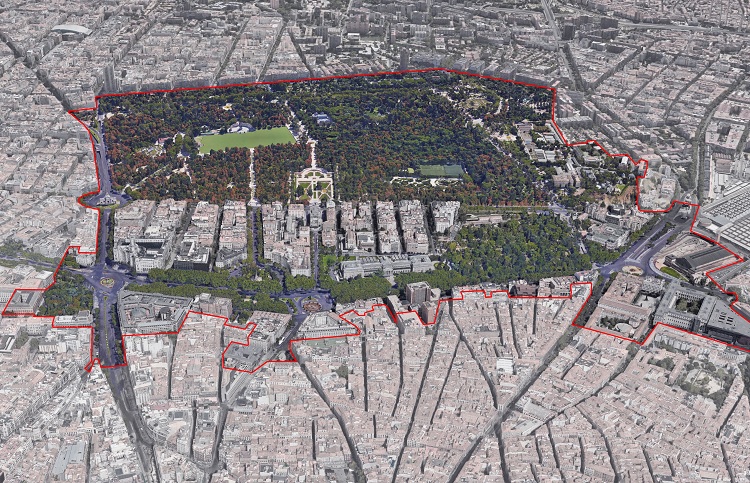The Diplomat
The ‘Landscape of Light’ of the Paseo del Prado and the Retiro was inscribed yesterday as a World Heritage Site by Unesco in 2021, which means that Madrid will finally cease to be the only capital of Western Europe without a property recognised in this category by Unesco.
The inscription of the “Landscape of Light”, which includes the tree-lined Paseo del Prado and the Retiro Park, together with 21 properties of cultural interest in its surroundings, went ahead despite the fact that the International Council on Monuments and Sites (ICOMOS) proposed that the candidacy be postponed, although it indicated the potential it could have in the tree-lined avenue criterion.
In the end, the nomination was put to a vote and approved by a sufficient majority of votes of the participating countries at the 44th session of the Unesco World Heritage Committee, held mainly virtually, but based in China.
The “Landscape of Light” will be the first world property inscribed in the capital of Spain and will join the already declared properties located in the Community: the Monastery of El Escorial, the University and Historic Centre of Alcalá de Henares, the cultural landscape of Aranjuez and the Montejo Beech Forest.
This is the culmination of work that began in 2014, when Ana Botella was at the head of the Mayor’s Office, continued as Mayoress Manuel Carmena and was completed by the current team led by José Luis Martínez-Almeida. The candidacy has been supported by the three administrations, central, regional and local, all of which had representatives yesterday at the “operations headquarters” set up in the Prado Museum. On behalf of the Government, the Ministers of Culture, Miquel Iceta, and Foreign Affairs were present at the headquarters; for the Community of Madrid, the President, Isabel Díaz Ayuso; and for the Madrid City Council, the Mayor himself.
All of them expressed their satisfaction after hearing the news, as did the head of the Executive, Pedro Sánchez, who, on his Twitter account, said that “Madrid and Spain are to be congratulated” and added that it is a “well-deserved recognition of a space in the capital that enhances our historical, artistic and cultural legacy”.
Minister Albares, for his part, said he felt “proud, as a Spaniard and as a Madrileño”, affirmed that what has been achieved is “an example of institutional collaboration” and thanked the Spanish ambassador to UNESCO, Andrés Perelló, for the work he had done. He ended by encouraging the people of Madrid to continue to enjoy this “Landscape of Light” and those who do not live in Madrid to come to Spain and its capital to visit what is already a World Heritage Site.
Martínez-Almeida expressed his gratitude for the consensus reached “in times of pandemic” around “a city that has had a tremendously difficult time, that has suffered a great deal over the last fifteen months and that finally has a reason to celebrate”. The mayor added that it is the “culmination of a dream that began in 2014” for a city that assumes “with respect, honour and responsibility” the inscription. “Madrid will be up to the task”, he assured.
The key argument for Madrid’s exceptional candidacy is that for the first time an urban green space was presented.
The Paseo del Prado first, in 1540, and the Retiro Gardens shortly afterwards, represented the first time in European urban planning that nature was introduced into the city. It is worth noting that the Paseo del Prado is the first tree-lined promenade, an alameda, to be designed in a European capital.
This model not only served as inspiration for the Alameda de Hércules in Seville, but also for the Alameda in Mexico (late 16th century) and the Paseo de los Descalzos in Lima (17th century).
It also implies that the Buen Retiro Palace and Gardens were installed there because of the existence of the Paseo del Prado. “Since the middle of the 17th century, the Paseo and the Gardens have been inextricably linked, being the centre of the Spanish Crown Court for more than 350 years”, the candidature states.
The arrival of the Bourbons in the 18th century saw the expansion of Enlightenment ideas. With Charles III, this area of the city was transformed into an enlightened city. The gardens were opened to all citizens and an area was created in it dedicated to research, study and the dissemination of knowledge for their enjoyment and instruction.
In the 19th century, part of the gardens were developed and, attracted by nature, artistic collections and scientific centres, the great political, economic and social institutions such as the Bank of Spain, the Congress of Deputies, the Royal Spanish Academy, the Stock Exchange and the great national museums were established in the area. It was also the site of the first major railway station, the Mediodía station, now known as Atocha.
It includes more than 21 assets of cultural interest and many of the funds and collections it contains are of universal dimension such as the Royal Academy, the works of Goya, Velázquez, Picasso, the collections of plates and archives of the Royal Botanical Garden or the Herschfeld telescope.






